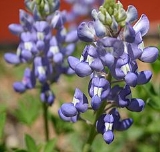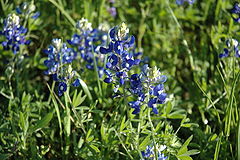
Lupinus texensis
Encyclopedia
Lupinus texensis is a species of lupin
e which is endemic
to Texas
. With other related species of lupines also called bluebonnets, it is the state flower of Texas.
It is a biennial plant
which begins its life as a small gravel-like seed. The seed has a hard seed coat that must be penetrated by wind, rain and weather over the course of a few months (but sometimes several years). In the fall the bluebonnets emerge as small seedings with two cotyledon
s, and later a rosette of leaves
that are palmately compound with 5-7 leaflets 3-6 cm long, green with a faint white edge and hair. Growth continues over the mild winter months and then in the spring will take off and rapidly grow larger before sending up a 20-40 cm tall plume of blue flowers (with bits of white and occasionally a tinge of pinkish-red).
It has been found in the wild with isolated mutations in other colors, most notably all-white flowers, pink, and maroon. These mutations have since been selectively bred to produce different color strains that are available commercially.

_field.jpg)
Lupin
Lupinus, commonly known as Lupins or lupines , is a genus in the legume family . The genus comprises about 280 species , with major centers of diversity in South and western North America , and the Andes and secondary centers in the Mediterranean region and Africa Lupinus, commonly known as Lupins...
e which is endemic
Endemic (ecology)
Endemism is the ecological state of being unique to a defined geographic location, such as an island, nation or other defined zone, or habitat type; organisms that are indigenous to a place are not endemic to it if they are also found elsewhere. For example, all species of lemur are endemic to the...
to Texas
Texas
Texas is the second largest U.S. state by both area and population, and the largest state by area in the contiguous United States.The name, based on the Caddo word "Tejas" meaning "friends" or "allies", was applied by the Spanish to the Caddo themselves and to the region of their settlement in...
. With other related species of lupines also called bluebonnets, it is the state flower of Texas.
It is a biennial plant
Biennial plant
A biennial plant is a flowering plant that takes two years to complete its biological lifecycle. In the first year the plant grows leaves, stems, and roots , then it enters a period of dormancy over the colder months. Usually the stem remains very short and the leaves are low to the ground, forming...
which begins its life as a small gravel-like seed. The seed has a hard seed coat that must be penetrated by wind, rain and weather over the course of a few months (but sometimes several years). In the fall the bluebonnets emerge as small seedings with two cotyledon
Cotyledon
A cotyledon , is a significant part of the embryo within the seed of a plant. Upon germination, the cotyledon may become the embryonic first leaves of a seedling. The number of cotyledons present is one characteristic used by botanists to classify the flowering plants...
s, and later a rosette of leaves
Leaf
A leaf is an organ of a vascular plant, as defined in botanical terms, and in particular in plant morphology. Foliage is a mass noun that refers to leaves as a feature of plants....
that are palmately compound with 5-7 leaflets 3-6 cm long, green with a faint white edge and hair. Growth continues over the mild winter months and then in the spring will take off and rapidly grow larger before sending up a 20-40 cm tall plume of blue flowers (with bits of white and occasionally a tinge of pinkish-red).
It has been found in the wild with isolated mutations in other colors, most notably all-white flowers, pink, and maroon. These mutations have since been selectively bred to produce different color strains that are available commercially.

_field.jpg)

